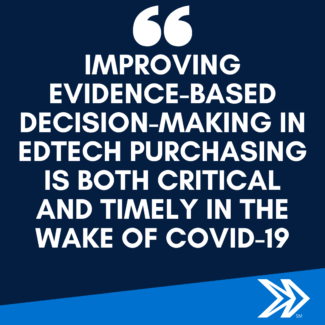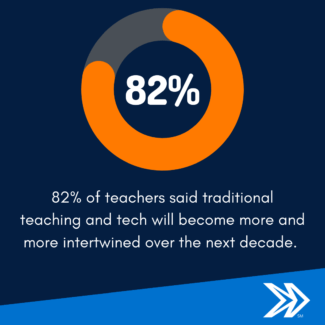March 11, 2021
Education technology, commonly known as EdTech, was a rapidly growing sector even before the pandemic upended traditional ways of teaching and learning. Over the past year, it has morphed from merely valued-added to critical as remote learning became the norm nationwide. Recent data suggests that 24% of school districts are operating fully in person, which leaves the remainder fully remote or hybrid. And many districts are building some form of hybrid instruction into their plans for 2022 and beyond, making investment in technology a priority.
 The Future of Ed-Tech
The Future of Ed-Tech
In a survey of 1,200 teachers (by Promethean), 82 percent said traditional teaching and tech will become increasingly intertwined over the next decade. According to NewSchools, which in early 2019 launched its Expanded Definition of Student Success Ed Tech Challenge, “the most promising tech innovations will support the development of a range of social-emotional competencies, cognitive skills, and attributes of positive learning environments.”
“Now that so many educators have had to communicate, learn and teach through the online medium, it can’t be ignored as an option to consider in the future, nor can the question be ignored of what tools could be brought to bear to improve the quality of learning in online and place-based environments,” Zachary Pardos, an assistant professor at UC Berkeley’s Graduate School of Education and the School of Information, told the Berkeley News last spring. “This is an opportunity to reflect on the challenges experienced during the pandemic, challenges such as lack of engagement and lack of a sense of connection with students. How can appropriate application of adaptive technology make online learning experiences whole, from both teacher and student perspectives?”
Funding Ed-Tech Solutions
Of course, more tech requires more funding — particularly in areas of the country (there are many of them) that typically get short-changed. A recent study by the Century Foundation think tank found that while public education in America is underfunded by $150 billion in general, “School districts with high concentrations of Latinx and Black students are much more likely to be underfunded than majority white districts, and face much wider funding gaps, an average deficit of more than $5,000 per student.”
 So if the government won’t step in, who will? In a story titled Re-Envisioning ‘Innovative Schools’ for 2021, the Overdeck Family Foundation strongly advocated for philanthropic assistance to make “supply-side bets on digital core curriculum that facilitates both grade-level and personalized learning.” The essay went on to discuss specific areas in which smart and targeted investment would be most useful, including tech-enabled math curricula, literacy interventions to address the reading gap between students of different economic means, and tutoring. Unfortunately, it noted, edtech budgets are often wasted on ineffective tech tools rather than ones that actually improve learning. “Improving evidence-based decision-making in edtech purchasing is both critical and timely in the wake of COVID-19,” it concluded.
So if the government won’t step in, who will? In a story titled Re-Envisioning ‘Innovative Schools’ for 2021, the Overdeck Family Foundation strongly advocated for philanthropic assistance to make “supply-side bets on digital core curriculum that facilitates both grade-level and personalized learning.” The essay went on to discuss specific areas in which smart and targeted investment would be most useful, including tech-enabled math curricula, literacy interventions to address the reading gap between students of different economic means, and tutoring. Unfortunately, it noted, edtech budgets are often wasted on ineffective tech tools rather than ones that actually improve learning. “Improving evidence-based decision-making in edtech purchasing is both critical and timely in the wake of COVID-19,” it concluded.
Security is Vital
Technology without security, experts will tell you, is very likely to create more problems than it solves. Without proper tools and protocols to guard student data and privacy, educational institutions are just asking for trouble. Big trouble. Here’s a disconcerting bit from the Cybersecurity Infrastructure & Security Agency, dated Dec. 10, 2020, that drives that point home: “The FBI, CISA, and MS-ISAC have received numerous reports of ransomware attacks against K-12 educational institutions. In these attacks, malicious cyber actors target school computer systems, slowing access, and—in some instances—rendering the systems inaccessible for basic functions, including distance learning. Adopting tactics previously leveraged against business and industry, ransomware actors have also stolen—and threatened to leak—confidential student data to the public unless institutions pay a ransom.”
That’s not a warning to ignore. It shouldn’t inhibit innovation, though. As with any tech that’s Internet-linked, sufficient protective measures are key to avoiding critical mishaps. With those in place, the pros of technologically enhanced education can far outweigh the cons. As the American philosopher and educational reformer John Dewey put it decades ago, “If we teach today as we taught yesterday, we rob our children of tomorrow.”
To gain more insight into cybersecurity trends in 2021 and actionable steps you can take to protect your data and assets, listen to our latest virtual event, Understanding the Real Costs of a Data Breach, featuring Mishaal Khan, Mindsight Cybersecurity Leader and Certified Ethical Hacker.
About Mindsight
Mindsight is industry recognized for delivering secure IT solutions and thought leadership that address your infrastructure and communications needs. Our engineers are expert level only – and they’re known as the most respected and valued engineering team based in Chicago, serving emerging to enterprise organizations around the globe. That’s why clients trust Mindsight as an extension of their IT team.
Visit us at http://www.gomindsight.com.
 The Future of Ed-Tech
The Future of Ed-Tech
